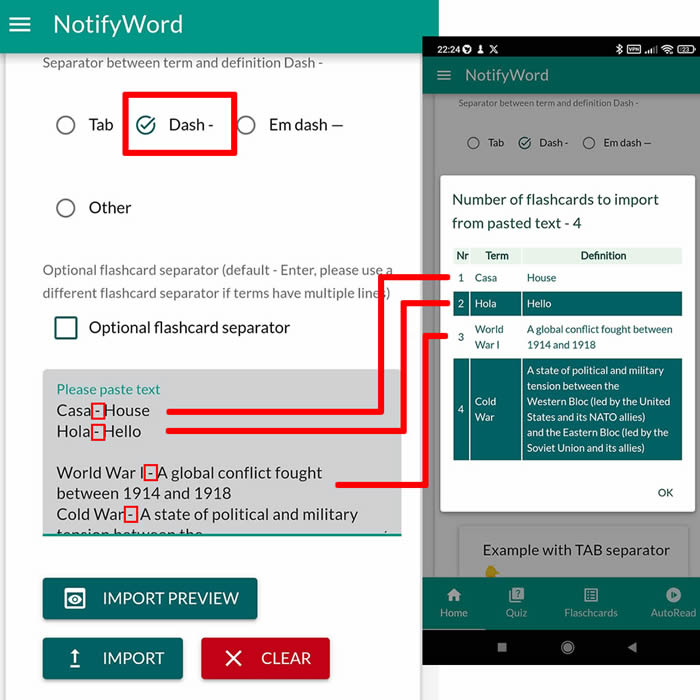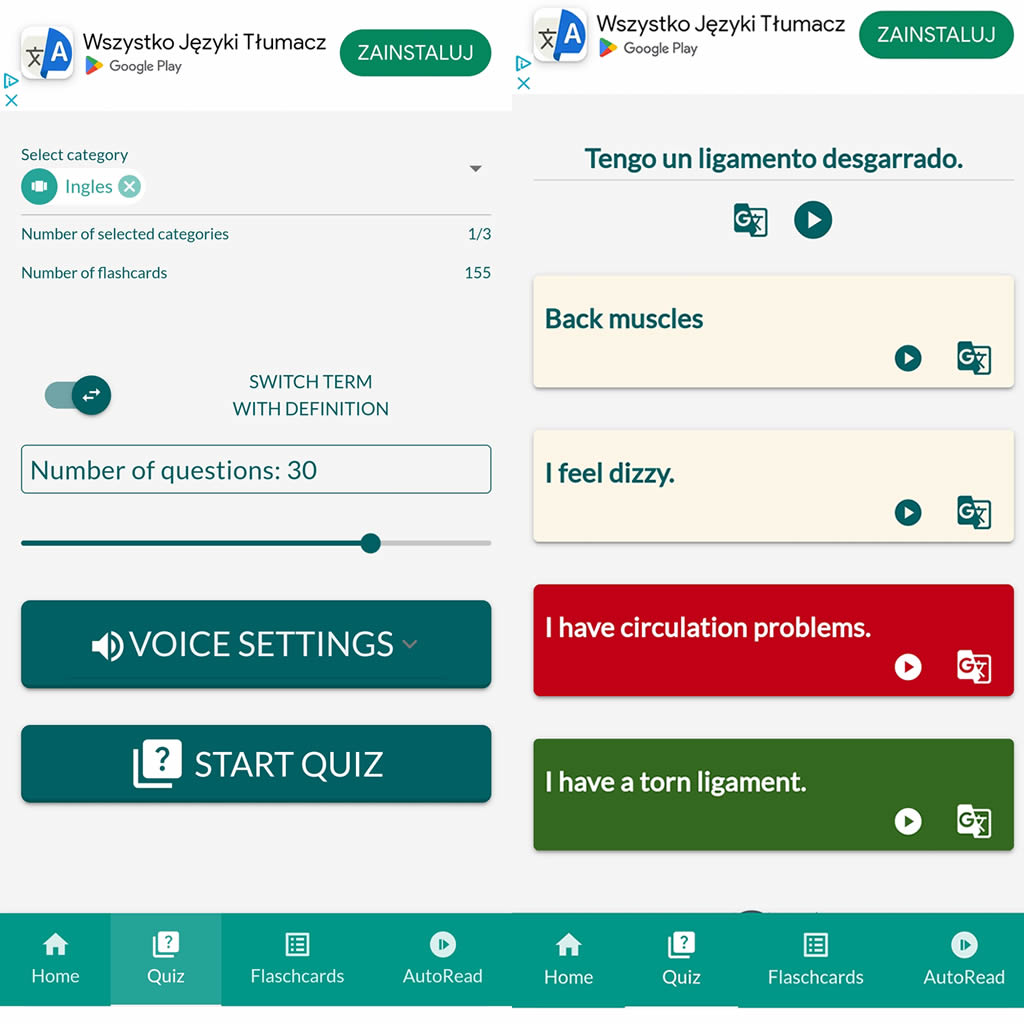AB PSYCH
tagPsychology
tagAbnormal Psychology
added by -
nglmrrz
Flashcards created on our website will become interactive after imported into the NotifyWord app on Android.
🤖📚📖❓🎧🚴 Voice flashcards - an Android app for learning without touching the phone.
➕ On the website, you can create your own sets of flashcards, both public and private, import them from text, and then import them into the Android application.
| Term/Front | Definition/Back |
|---|---|
|
1 Classical Conditioning Operant Conditioning Systematic Desensitization |
Behavioral Theory |
|
2 Self-Actualization Person-Centered Therapy - C. Rogers Unconditional Positive Regard |
Humanistic theory |
|
3 Defense Mechanisms Provinces of the mind The Unconscious mind Psychosexual Stages |
Psychoanalytic theory |
| 4 Founded the York Retreat, a private asylum in York. It was here that the development of moral treatment and 'non-restraint' policy in public asylums began. | William Tuke |
| 5 A Sunday school teacher in prison, her goal was to fully understand the mistreatment and abuses that patients experienced so she could change the situation. From there, her mental hygiene movement advocated for eliminating social prejudice. She and her followers fought for basic human dignity. | Dorothea Dix |
|
6 He proposed a new, nonviolent approach to the care of mental patients came to be called moral treatment, in the sense of social and psychological factors. He strongly argued for the humane treatment of mental patients, including a friendly interaction between doctor and patient. His treatment was marked by gentleness, understanding, and goodwill. He was opposed to violent methods - although he did not hesitate to employ the straitjacket or force-feeding when necessary. |
Philippe Pinel |
| 7 Dementia associated with advanced neurosyphilitic infection of the brain, a condition that is now extremely rare because it is usually diagnosed and treated in its early stages. | General Paresis/Syphilis |
|
8 Greek physician and is a follower of Hippocrates • Used science to contribute to the field • Elaborated on nervous system based on animal dissections • Divided the causes of psychological illnesses into 2 categories Physical: injuries to the head, adolescence, menstrual changes Mental: shock, fear, love |
Galen (A.D. 130-200) |
| 9 Originally developed by Hippocrates and was further developed and elaborated by Galen in the second century. | Humoral theory |
| 10 Inflammation of the brain | Phrenitis |
| 11 wandering uterus | Hysteria |
| 12 The first symptoms appear 5 to 30 years after the primary infection. Psychological signs are irritability, confusion, fatigue, and forgetfulness, followed by headaches, confabulation, and deterioration in behavior and judgement. | General Paresis/Syphilis |
| 13 Hippocrates believed that it is the central organ of intellectual activity. Hence, mental disorders are due to brain pathology. | The brain |
|
14 He believed that mental disorders were due to natural causes such as medical model of disordered behavior. He also pointed out that head injuries could lead to sensory and motor disorders. More so, he also emphasized the importance of heredity and predispositions. |
Hippocrates (460-370 B.C.) |
|
15 One treatment involved mummifying the patient in towels soaked in ice-cold water. Another required the patient to remain continuously submerged in a bath for hours or even days-which might not sound so bad, except they were strapped in and only allowed out to use the restroom. Finally, some doctors ordered the use of high-pressure jets. Sources indicate that at least one patient was strapped to the wall in the crucifixion position (never a good sign) and blasted with water from a fire hose. |
Hydrotherapy |
|
16 American physician used the treatment for psychiatric purposes. He believed that spinning would reduce brain congestion and, in turn, cure mental illness. He was wrong. Instead, he just ended up with dizzy patients. These days, rotating chairs are limited to the study of vertigo and space sickness |
Rotational Therapy - Benjamin Rush |
| 17 Developed during the 1940s and 1950s, it was always controversial and prescribed in psychiatric cases deemed severe. It consisted of surgically cutting or removing the connections between the prefrontal cortex and frontal lobes of the brain. | Prefrontal lobotomy - Egas Moniz |
|
18 This treatment was introduced in 1927 and was used for several decades until the 1960s. In insulin coma therapy. Patients were given an insulin injection that caused their blood sugar to fall and the brain to lose consciousness. Risks included prolonged coma (in which the patient failed to respond to glucose), and the mortality rate varied between 1 and 10 percent. |
Insulin shock therapy - Manfred Sakel |
| 19 It was later introduced as a safer alternative to insulin coma therapy. | Electroconvulsive therapy |
| 20 Isolation was the preferred treatment for mental illness beginning in medieval times, so it's no surprise that it became widespread by the 17th century. These institutions were places where people with mental disorders could be placed, allegedly for treatment, but also often to remove them from the view of their families and communities. | Mental Asylums |
| 21 Galen believed that disease and illness stemmed from imbalanced humors in the body. This english physician used Galen's writings as a basis for this approach to treating mentally ill patients. He argued that an internal biochemical relationship was behind mental disorders. Bleeding, purging, and even vomiting were thought to help correct those imbalances and help heal physical and mental illness. | Blood Purging - Thomas Willis |
| 22 Trepanning, also known as trepanation, trephination, trephining or making a burr hole (the verb trepan derives from Old French from Medieval Latin trepanum from Greek trypanon, literally "borer, auger") is a surgical intervention in which a hole is drilled or scraped into the human skull to give a trapped demon a hole to escape, or so it was believed |
Trephination |
|
23 A psychological illness characterized by an extreme impulse to dance, prevalent in southern Italy from the 15th to the 17th century, and widely believed at the time to have been caused by the bite of a tarantula. |
St. Vitus Dance = Tarantism |
|
24 Swiss Physician in the 14th Century |
Paracelcus |
|
25 Abnormal behavior was due to celestial misalignment of the moon and stars |
Lunacy Trials |
| 26 This refers to a belief that an evil spirit can cause possession of the human mind and body. Whereas, Exorcism (Greek, Exorkismos, means “binding the oath”) is the religious or spiritual practice of evicting demons or other spiritual entities from a person, or an area, that is believed to be possessed. | Demonology |
| 27 The study of origin of a disorder (includes biological, psychological , and social dimensions | Etiology |
| 28 The prospect of recovery as anticipated from the usual course of disease or peculiarities of the case | Prognosis |
| 29 gradual | Insidious onset |
| 30 abrupt | Acute onset |
| 31 refers to the development of the disease in a patient, including the sequence and speed of the stages and forms they take | Course |
|
32 It is a measure of disease that allows us to determine a person's probability of being diagnosed with a disorder during a given period of time. |
Incidence |
| 33 the number of prevalent cases is the total number of cases of disorders existing in a population | Prevalence |
| 34 the simultaneous presence of two or more diseases or medical conditions in a patient | Comorbidity |
| 35 describe the reason the client came to you. Include the client's definition of their problem, how long they've been experiencing the issue and what they expect to gain from your services. Also, describe what the client has done in the past to try to resolve the issue | Presenting problem |
|
36 Balancing Practice and Science. This integrates and connect scientific insights into practice by making use of scientifically validated methods, techniques and protocols when giving psychological assessments, and by contributing to practice-based research and the development of effective psychological services |
Scientist-Practitioner Model (Boulder) |
|
37 Learning Toward Practice. Less extensive training in research and more extensive training in the development of applied clinical skills |
Practitioner-Scholar Model (Vail) |
|
38 Learning Toward Science. This practice stressed the scientific side of clinical psychology training |
The Clinical Scientist Model |
| 39 During his manic phases of bipolar disorder, Michael will often go to the casino and bet his rent money on roulette, not caring that if he loses he won't be able to pay for his apartment. |
Danger |
| 40 Emily was seen to be talking loudly on a cellphone in a quiet movie theater. This disrupts the experience for others and violates informal social norms. |
Deviance |
|
41 Sarah, a 22-year-old college student who has always been a bit on the shy side however, a few weeks ago, Sarah experienced distress related to social situations. She worries excessively of being ridiculed and judged. This anxiety manifest as sweating, rapid heartbeat and nausea in social settings. |
Distress |
|
42 Three weeks ago, Aya, 28-year-old business executive, stopped showering, refused to leave her apartment, and started watching tv shows. Threats of being fired have failed to bring Aya to reality and continues to spend her days staring blankly in the television. |
Dysfunctional |
| 43 Behaviors are the detrimental to the person or people around them |
Danger |
| 44 This is when a behavior differs from what is normal or accepted |
Deviance |
| 45 a behavior that is found offensive and unacceptable in a social group |
Social Deviance |
| 46 behavior that does not follow the norms upheld by a majority of people in a given situation |
Statistical Deviance |
| 47 This is when a behavior causes anxiety, bad feelings or other negative feelings for either the person or others who come in contact with them |
Distress |
| 48 This is the point at which a person has a significant impairment in a life area, such as work, home, interpersonal or social life is impaired. In the addictions world, this is often called "hitting rock bottom" |
Dysfunctional |
| 49 It is the expected behavior or way of living based on what is commonly observed in the majority of the population |
Normal |
| 50 There is no single determinant or generally accepted definition of abnormality. However, there are several elements that may help in determining the presence of abnormality in an individual | Abnormal |
|
51 Any behavioral, psychological, or biological dysfunctions that are unexpected in their cultural context associated with present distress and impairment in functioning, or increased risk of suffering, death, pain, or impairment (DSM-5-TR) |
Psychopathology |
|
52 Offers guidance to individuals, groups, and community on issues affecting mental health. |
Mental Health Coaches/counselors |
| 53 Evaluate and treat mental and emotional disorders, other health and behavioral problems, and address a wide array of relationship issues within the context of marriage and family |
Marriage and Family Therapist |
| 54 Obtained advance education and training and care of patients with mental health illness | Psychiatry Nurses |
| 55 Experts in collecting relevant information about an individuals social and family background |
Psychiatry Social Worker |
|
56 Evaluate, diagnose and treat psychiatric disorders Prescribe medications Take a biological perspective in treatment |
Psychiatrists |
| 57 Conducts research studies to contribute to the understanding of mental illness |
Clinical and counseling psychologist |
| 58 A psychologist who focuses on psychopathology |
Clinical psychologists |
| 59 A psychologists who help patients or clients address emotional, social, and physical stressors in their lives. |
Counseling psychologists |
|
60 Administering and scoring objective tests Interpreting test results and creates psychological report Conduct preparatory intake interview Test Development |
Psychometrician |
| 61 is also termed as “psychopathology” | Abnormal Psychology |
| 62 It is a scientific discipline that studies unusual patterns of thoughts, emotions, and behavior associated with mental illness |
Abnormal Psychology |
ℹ️ Flashcards created on our website will become interactive after imported into the NotifyWord app on Android.☝️
📚✍️📲 You can copy the flashcards to your set, copy the flashcards and paste them in the import tab by selecting the TAB separator.











